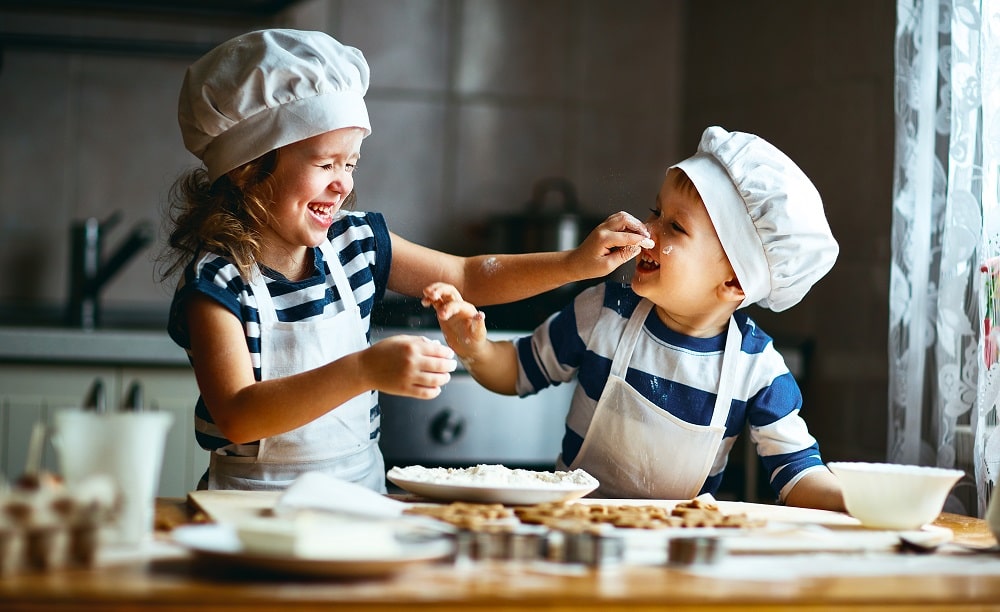Your child is growing fast. It won’t be too long before your child begins their formal education in school. This brings a lot of excitement but also some trepidation. Will they be ready to make this big step?
Teachers of mathematics in Dubai know that parents always want their children to start school feeling confident and ready to learn. With that in mind, here are some math activities for your preschool child that will help them prepare for learning this subject at school. Most importantly, you and your child will enjoy them!
1. Baking
Baking comes very highly “teacher-recommended.” There are many, many benefits to it. Firstly, it’s the perfect example of everyday number use in action. As well as the weighing and measuring, you will be counting eggs and setting a timer. You can talk about the shape of the cake tin or cookie cutters. Once you have your finished bake, you can talk about sharing, maybe even halves and quarters, which leads towards fraction work at school.
You’ll use so many number words together, plus your child will be learning just how important math is in the real world. That’s a really important lesson for young children to learn so that they are excited and motivated to learn math in school.
As well as math skills, your child will gain other useful skills for school, such as following instructions and working as a team towards a common goal. Stirring, mixing, rolling and kneading are also great for strengthening little hands and arms, ready for learning to write.
2. Counting practice
There are two aspects to learning to count. First is that your child needs to say numbers in the right order: One, two, three, four. The second aspect is “one-to-one correspondence.”
One-to-one correspondence is the concept that a number matches an amount of something. In other words, it is the child’s ability to point to objects as they count and then correctly tell you how many there are in total.
Counting and one-to-one correspondence are the foundations for all the number work your child will do through school, so it’s great to make a start with it if you feel your child is ready. The very best way to teach counting and correspondence is to model doing it and encourage them to join in. Count out anything and everything: building blocks, pieces of fruit, cars as they pass your window, stairs as you climb them, or socks going into the laundry.
3. Number spotting fun
Your child will eventually need to be able to read numbers as well as operation signs like “+” and “-”. To introduce this, you can play a version of number eye spy with your child. Introduce what a single-digit number looks like in written form and then play a game of spotting it around the house and out and about. Your child will soon realize just how important numbers are to everyday life.
You can even practice early number writing skills by encouraging your child to draw a number in sand, write it with pavement chalk or even draw it in the air with their finger.
Just be sure to go slowly and not introduce too many numbers at once.
4. Playing with blocks
One toy that is superb for practicing math is a box of bricks. We’ve already mentioned you can use them for counting practice. However, they have many more benefits.
“Shape and space” is a really important area of the math curriculum. Building blocks are most children’s first experience with it. By playing alongside your child, you can teach them so much of the language they’ll need when they learn about shape and space at school. These are words like “side,” “edge” and “corner.” They can also learn the language to talk about position and movement, like “above” or “behind.”
Problem-solving is another skill that emerges from playing with toys like this. For example, if your child is trying to build a tower, you’ll see them developing the ability to use trial and error and skills in evaluation. These skills will be really valuable for their learning in all subjects at school, especially math.
5. Jigsaw puzzles
Jigsaw puzzles will also help your child develop early problem-solving skills. These toys are great for working on spatial awareness and the beginnings of geometry. Again, you will be able to teach your child lots of language of shape, space and position like “corner” and “next to.”
There are lots of jigsaw puzzles available for young children. For toddlers, peg puzzles work well as they are easier to handle. As your child’s fine motor skills come along, they will be able to handle a regular jigsaw puzzle. Some puzzles for young children come in as few as four or six pieces. As your child’s problem-solving skills develop, they can move on to puzzles with more and more pieces.
Keep it hands-on and fun
Young children learn best through fun hands-on activities, and this is how your child will be learning in early math classes for kids at school. If your child isn’t enjoying an activity or toy, leave it and try again in a few weeks. It may just be a little too early in their development or they may simply not be in the mood that day. Your child will get the best start in math if they enjoy it from its very beginning. Playing, talking and having fun together is the ideal way to introduce math into your child’s life.
AUTHOR BIO
Maloy Burman is the Chief Executive Officer and Managing Director of Premier Genie FZ LLC. He is responsible for driving Premier Genie into a leadership position in STEM (Science, Technology, Engineering and Mathematics) Education space in Asia, Middle East and Africa and building a solid brand value. Premier Genie is currently running 5 centers in Dubai and 5 centers in India with a goal to multiply that over the next 5 years.

